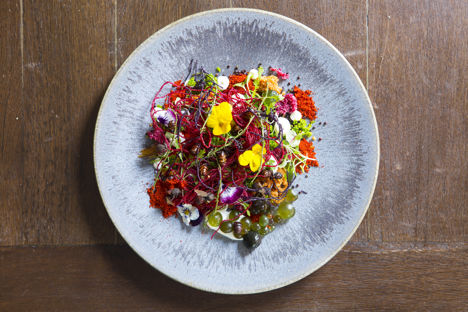
Mind to menu: Robert Ortiz's ants, kiwicha and cushuro
While some might baulk at the prospect of eating ants, for Robert Ortiz the insects carry happy memories of his childhood in Peru. The chef talks us through the various components of his colourful, nostalgic edible insect recipe, a dish inspired by the Peruvian landscape.
Mind to menu: Robert Ortiz's ants, kiwicha and cushuro
While some might baulk at the prospect of eating ants, for Robert Ortiz the insects carry happy memories of his childhood in Peru. The chef talks us through the various components of his colourful, nostalgic edible insect recipe, a dish inspired by the Peruvian landscape.
Noma’s use of live ants on the menu might’ve made edible insects unlikely darlings of the fine dining world in recent years, but for Robert Ortiz they represent nostalgia more than a headline-grabbing food trend. Growing up in Peru, the chef and his friends would look forward all year to late October, which heralded the beginning of the blink-and-you’ll-miss-it season for ants. During this time, a period usually lasting no longer than a month, the ants could appear at any moment, although they were particularly likely to be seen after it had rained (which would turn the ground a vivid red). Only the atmosphere dictated their arrival, and while many would try to smoke, dig or coax the ants out early these attempts were always unsuccessful. When the swarms did emerge children would run around catching the ants, and if unprepared when they made their appearance, would stash the live insects in their socks for later. ‘You’d have to make sure you removed the spiky ends from around the ants’ heads first,’ recalls Robert, ‘or by the time you’d get home they would’ve eaten through your socks!’
Once home the ants would be toasted in a little oil and eaten as a snack ‘just like popcorn’, or ground into a colourful crumbly purée to marinate meat or spread on bread – think a flavour-packed paste like ‘nduja. Ant season was a time of great excitement for everyone (according to Robert 99% of villagers would eat them), although children were particularly adept at catching the ants and would make extra money selling them by the side of the road.
In Peru the children sell these ants for around £5 per kilo, but for Robert to ship the insects to the UK it costs over four times that amount. It's a price he's more than happy to pay to spread the love of this plump-bottomed insect, with the ants served as an unusual amuse-bouche at Lima this Valentine's Day. Appreciating that this might be a bit of a leap from oysters and olives for some people, Robert serves only the bodies of the ants to save people having to pause from their sweet nothings to spit wings and antennae into their napkins.
The stunning plating of the dish is particularly evocative, placing the ants back into a technicolour representation of the earth. Red powder, made from a mixture of bread and achiote oil, represents the colour of the ground after the rain, black quinoa replaces soil and a scattering of edible flowers adds further earthy elegance. Kiwicha, coloured with coriander and beetroot, also helps to create a vibrant colour palette on the plate, contrasted by dots of creamy Greek yoghurt.
Ants aside (there's something I never thought I'd say about a plate of food), one of the most striking components of the dish is the little pile of green balls sitting at the side of the plate. These balls, which have a squishy texture reminiscent of the liquid-filled bath balls popular in gift baskets in the nineties, are another Peruvian delicacy known as cushuro. A product of rainwater solidifying in the freezing temperatures of the Andes, the liquid forms small, pliable balls before hitting the ground and absorbing colour and flavour from the surrounding landscape. The chef compares them to a naturally occurring caviar, full of proteins with a slightly grassy taste.
Toasted ants have a similar salty taste to pork scratchings, with a very crisp outer shell and lingering aftertaste that is not unpleasant. If you're reading this and still feeling unconvinced, then you might be surprised to know that the flavour of these ants could be more familiar than you think. As Robert explains, 'these ants are used a lot in other things for flavour and colours, including yoghurt, syrups and liqueur'. By this logic, the chef reasons, there's no need to be squeamish: 'I don't think people should be afraid to eat these, because they've probably already tried them!'.
Ants sales are unlikely to outstrip those of lobster or scallops anytime soon, but hopefully this dish will go some way to helping people appreciate insects as an ingredient with meaning outside the initial shock factor. For Robert, meanwhile, to serve ants on a menu like this makes perfect sense. With such a short availability during the year these ants are extremely special, and there is something romantic (in the old fashioned sense of the word) about these stubborn little ants who bring pleasure to so many people.


